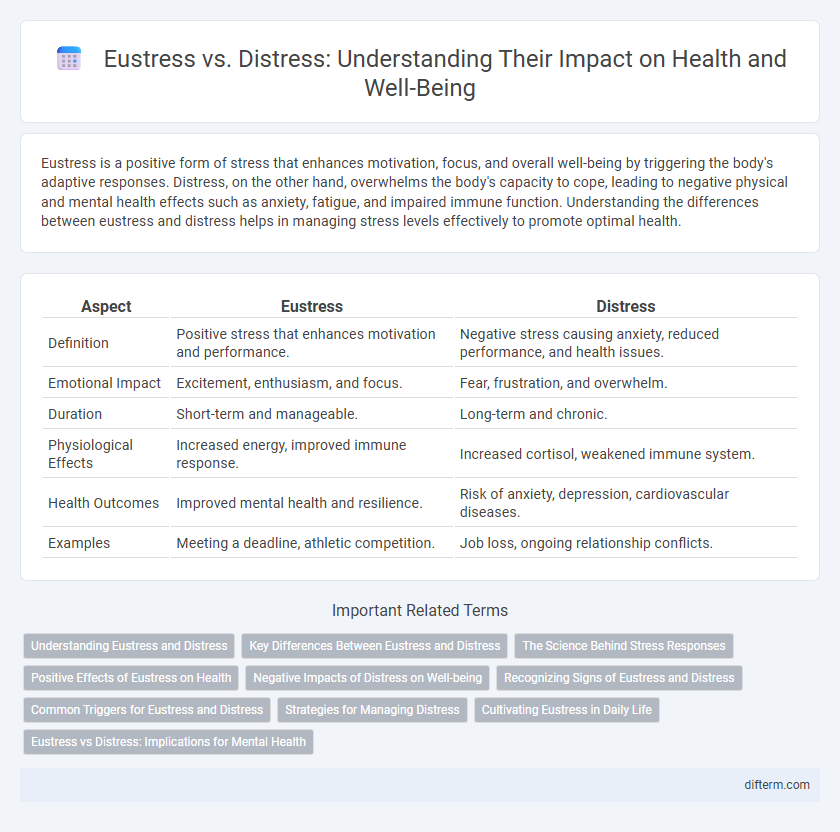Eustress is a positive form of stress that enhances motivation, focus, and overall well-being by triggering the body's adaptive responses. Distress, on the other hand, overwhelms the body's capacity to cope, leading to negative physical and mental health effects such as anxiety, fatigue, and impaired immune function. Understanding the differences between eustress and distress helps in managing stress levels effectively to promote optimal health.
Table of Comparison
| Aspect | Eustress | Distress |
|---|---|---|
| Definition | Positive stress that enhances motivation and performance. | Negative stress causing anxiety, reduced performance, and health issues. |
| Emotional Impact | Excitement, enthusiasm, and focus. | Fear, frustration, and overwhelm. |
| Duration | Short-term and manageable. | Long-term and chronic. |
| Physiological Effects | Increased energy, improved immune response. | Increased cortisol, weakened immune system. |
| Health Outcomes | Improved mental health and resilience. | Risk of anxiety, depression, cardiovascular diseases. |
| Examples | Meeting a deadline, athletic competition. | Job loss, ongoing relationship conflicts. |
Understanding Eustress and Distress
Eustress is a positive form of stress that enhances motivation, focus, and performance, promoting overall well-being and growth. Distress, in contrast, is negative stress that can lead to anxiety, decreased productivity, and health problems if prolonged. Understanding the differences between eustress and distress is crucial for managing stress effectively and maintaining mental and physical health.
Key Differences Between Eustress and Distress
Eustress is a positive form of stress that enhances motivation, focus, and performance, whereas distress is negative stress that leads to anxiety, decreased productivity, and potential health issues. Eustress triggers adaptive biological responses, such as improved cortisol regulation and increased adrenaline, while distress often results in chronic activation of the stress response, causing inflammation and weakened immune function. Key differences also include perception and outcome: eustress is perceived as manageable and beneficial, promoting resilience, while distress is seen as overwhelming and harmful, contributing to mental and physical illness.
The Science Behind Stress Responses
Eustress activates the sympathetic nervous system, releasing adrenaline and cortisol that enhance focus and energy levels, promoting optimal performance and resilience. Distress triggers prolonged stress hormone secretion, which impairs cognitive function, weakens the immune system, and increases the risk of chronic diseases. Neuroscientific studies reveal that balanced stress responses involve the hypothalamic-pituitary-adrenal (HPA) axis regulation and prefrontal cortex engagement to maintain mental and physical health.
Positive Effects of Eustress on Health
Eustress triggers the release of endorphins and adrenaline, enhancing mental focus and physical performance. It strengthens the immune system by promoting resilience against stress-related illnesses. Regular exposure to eustress supports improved mood, increased motivation, and overall well-being.
Negative Impacts of Distress on Well-being
Chronic distress triggers elevated cortisol levels, impairing immune function and increasing susceptibility to illness. Persistent negative stress contributes to anxiety, depression, and cardiovascular diseases, significantly reducing overall quality of life. Prolonged exposure to distress disrupts sleep patterns and cognitive performance, further deteriorating mental and physical health.
Recognizing Signs of Eustress and Distress
Eustress often manifests through increased motivation, enhanced focus, and improved performance, signaling a positive response to manageable challenges. In contrast, distress is marked by symptoms such as chronic fatigue, anxiety, and irritability, reflecting overwhelming stress that impairs well-being. Recognizing these signs early enables effective stress management strategies to maintain mental and physical health.
Common Triggers for Eustress and Distress
Common triggers for eustress include challenges such as starting a new job, taking on a creative project, or engaging in competitive sports, which motivate and enhance performance. Distress often arises from pressures like excessive workload, financial problems, or interpersonal conflicts, leading to anxiety and decreased well-being. Recognizing these triggers helps individuals manage stress effectively by fostering positive stimuli and mitigating harmful stressors.
Strategies for Managing Distress
Effective strategies for managing distress include practicing mindfulness meditation, which helps regulate emotional responses and reduces cortisol levels. Regular physical exercise promotes the release of endorphins, enhancing mood and resilience against stressors. Cognitive-behavioral techniques, such as reframing negative thoughts and developing problem-solving skills, also significantly improve stress management outcomes.
Cultivating Eustress in Daily Life
Eustress, a positive form of stress, enhances motivation, focus, and resilience by triggering beneficial physiological responses. Cultivating eustress in daily life involves engaging in challenging but manageable tasks, setting achievable goals, and practicing mindfulness to maintain optimal stress levels. Regular exposure to eustress supports mental health, improves performance, and fosters adaptive coping mechanisms essential for well-being.
Eustress vs Distress: Implications for Mental Health
Eustress, a positive form of stress, enhances motivation, focus, and resilience, promoting mental well-being by triggering adaptive physiological responses. In contrast, distress, characterized by overwhelming pressure and negative emotions, impairs cognitive function and increases the risk of anxiety, depression, and chronic stress disorders. Understanding the balance between eustress and distress is essential for developing effective mental health strategies and improving stress management techniques.
Eustress vs Distress Infographic

 difterm.com
difterm.com